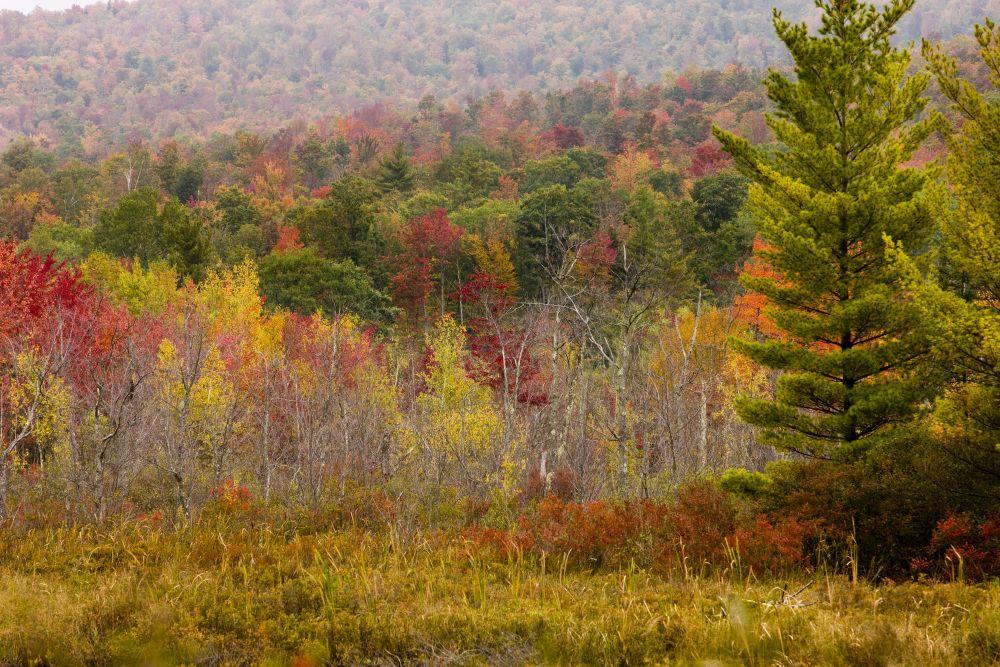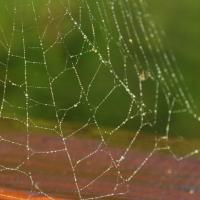Nature's View
- Tags:
- Recreation

By October, the interaction of fading daylight on leaves unfurls the pennants of fall. Warm, sunny days following cool, frosty nights are prime ingredients for spectacular foliage. Photo by Jerry and Marcy Monkman, EcoPhotography.
In the woods, each seasonal transition is accompanied by faint glimmers of what comes next and ghosts of each fleeting moment. Later sunrise and earlier sunset times now stagger in slow-motion toward an embrace they thankfully never reach. Field crickets chirp in lengthening darkness of approaching autumn evenings. I feel the changes too.

Forests are full of trustworthy harbingers who sing songs or send subtle signs. The rare, golden autumn quality to afternoon sunlight is different from the hard summer glare of just a few weeks ago. The momentary sunbeam illuminating a floating gossamer strand of spider silk suddenly portends an entire cascade of change.
Autumn offers a faded and dry vestige of a once-verdant forest drenched in bird song. For birds, the young of the year are fullyfledged, grown, and dispersed. Once riotous bird song in this exact locale is now deafening silence. Fragments of song are practiced by fledglings, a weak reprise of the summer symphony heard but only briefly each dawn. Adults feed actively while quietly molting into drab fall plumage. They perch in a fading canopy of ragged leaves, weatherworn and pocked with insect damage. Fall migration is underway.

“These days are numbered,” I sigh at first sight of crimson leaves on the wetland edge swamp maples. Trees adapted to living in wetlands are among the last to leaf-out early autumn. How do seemingly inanimate trees measure the changing season? Northern trees quietly prepare for their winter. Conifers form waxy buds and begin to close needle pores, ceasing the gaseous exchange of photosynthesis. Hardwood leaves fade when green chlorophyll production slows. The unstable glucose molecules produced in leaves all summer are moved via sap to roots to be stored as more stable starch. A vast array of leaves, hundreds of millions of leafy solar collectors, translocate the annual gross domestic product to their root cellars for another coming winter.
Relative concentrations of leaf chemicals called “phytochromes” produced inside leaves during longer dark periods begin to exceed those produced during short, sunlit hours. In response to changes in relative phytochrome concentrations, plant hormones signal leaves to form a corky “abscission layer” to seal off leaf stems called “petioles.” You can hear the audible snap of leaf petioles on frosty, October mornings as trees discard their spent solar panels.

Chlorophyll production ceases entirely. The residual green pigment breaks down, and the underlying yellow and orange secondary pigments are slowly revealed. Other hormones trigger production of red and purple secondary pigments where leaves remain exposed to weaker autumn sunlight. Red “Anthocyanin” pigments are responsible for the red, purple, and blue colors of fruits, vegetables, cereal grains, and flowers. Anthocyanin pigments are brilliant scarlet colors in the sun-lit sugar maples, quintessential icons of the autumn foliage season.
Warm, sunny days following cool, frosty nights are prime ingredients for a spectacular fall foliage. The phenomenon is an outward manifestation of hidden leaf chemistry. Plant metabolism underlies singular events we most associate with New England: maple syrup and autumn foliage. We inhabit a landscape of trees.
By October, the interaction of fading daylight on leaves unfurls the pennants of fall. When we heed their annual message, we can’t ignore the undeniable metaphors for birth, growth, life, and death.
